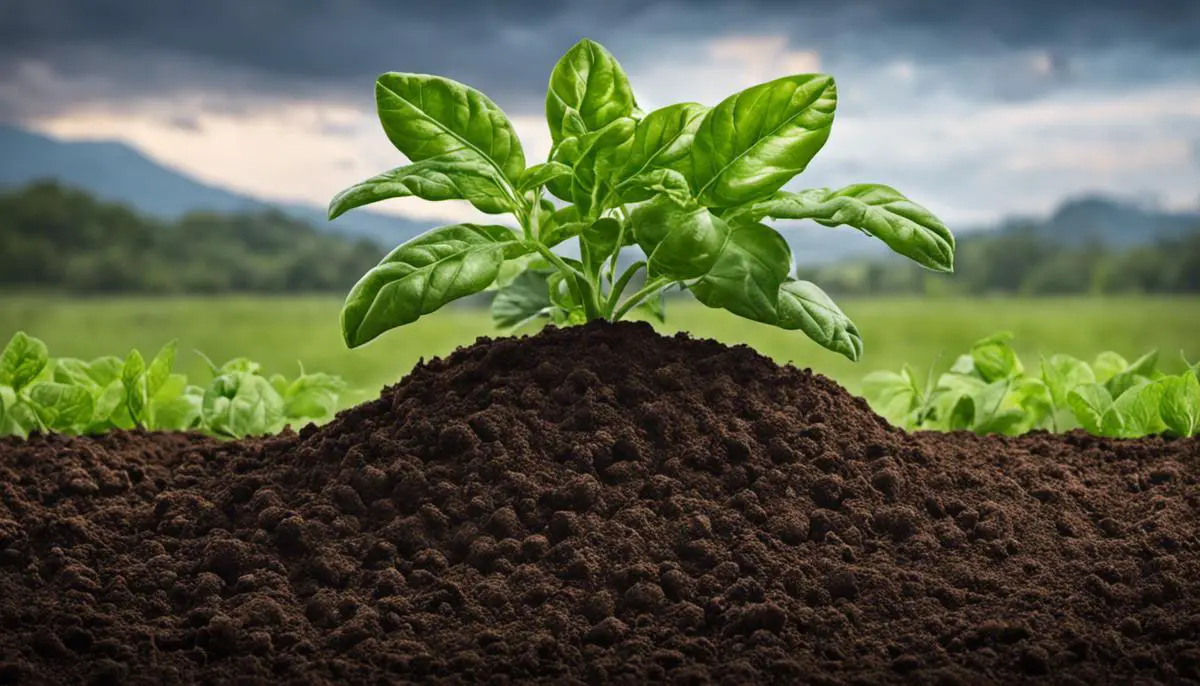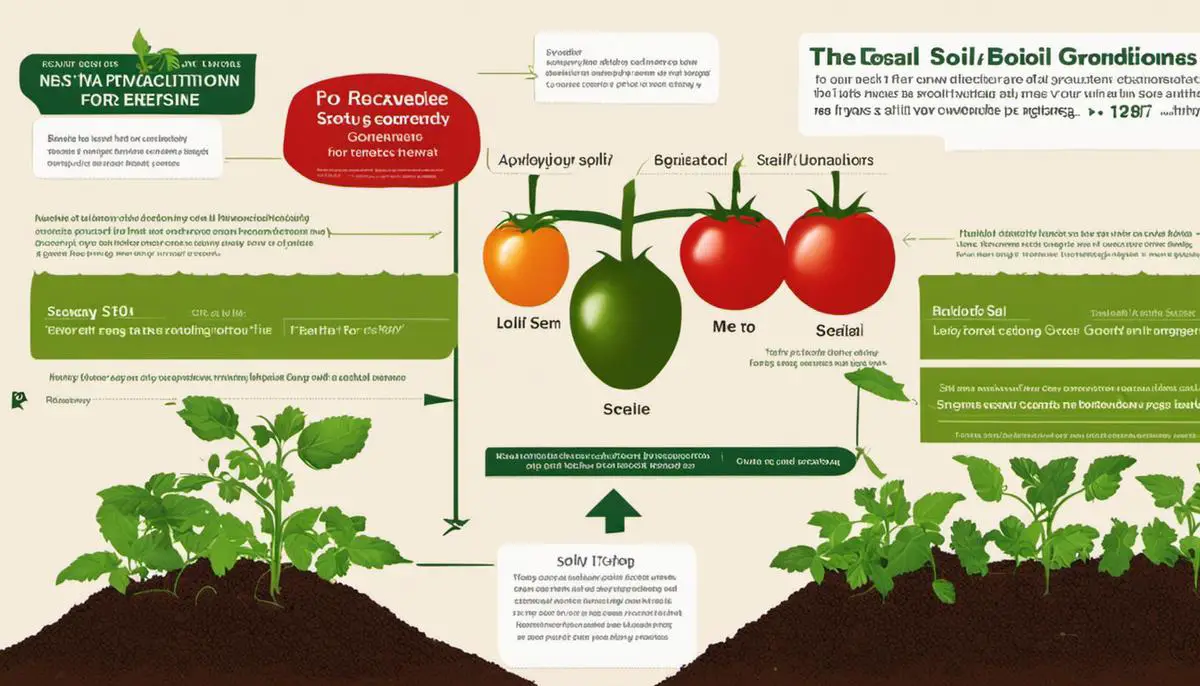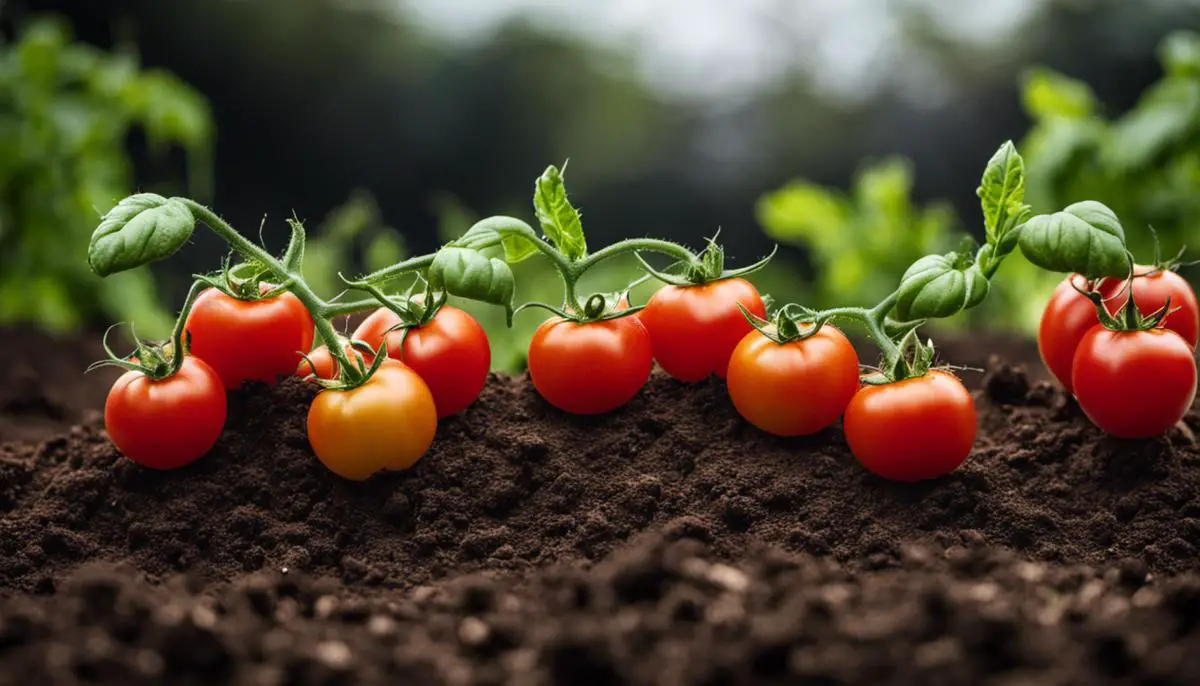Table of Contents
Growing delectable, robust tomatoes begins not only with selecting the right variety or ensuring adequate sunlight but fundamentally with understanding the complexities of the soil in which they are cultivated. This key component of organic farming, often adjudged ‘the living skin of the earth,’ serves as the main nutritional and support base for our much-beloved tomatoes. Hence, there is a pressing need to comprehend the essence of the soil basics ranging from pH levels to texture nuances. Moreover, as every gardening enthusiast will agree, coming to grips with the very specifics of ideal soil conditions can make the difference between a bumper tomato harvest and a disappointing crop. Whether one opts for commercial tomato-growing soil mixes or prefers to mix up a batch at home, it’s clear that knowledge of what works best is invaluable. Additionally, understanding the role of various soil amendments in elevating the health and yield of tomato plants can empower gardeners to make the right choices for their soil enhancement strategies. Not least, maintaining soil health through methods like crop rotation and regular soil testing forms the cornerstone for a sustainable tomato farming endeavor.
Understanding Soil Basics
Understanding Soil Basics for Tomato Growth
Growing the perfect tomatoes starts with understanding the basics of soil. Certain soil types are preferable for tomato growth. The elements that come into play include the pH levels of the soil, soil texture, structure, nutrition, and water retention. Understanding these aspects of soil can lay the groundwork for successful tomato cultivation.
An essential component of ideal tomato soil is the pH level.
Tomatoes thrive best in slightly acidic soil, with a pH ranging from 6.0 to 6.8. The pH value determines the nutrient availability in the soil. A pH scale below 6 may lead to nutrient deficiencies, while a pH above 7 will cause nutrients to become less soluble and harder for the plants to absorb. Hence, maintaining a balanced pH level is crucial for tomato growth.
The texture of the soil impacts the root growth and nutrient uptake of the tomato plants.
The ideal soil for tomatoes is loamy soil, which is a composition of sand, silt, and a little bit of clay. The loamy soil has a fine yet crumbly texture that enables the roots to penetrate easily, improving nutrient absorption. In contrast, clay soil is dense and hard for roots to penetrate, while sandy soil drains water too quickly, depriving the plants of necessary moisture.
Soil structure refers to the arrangement of the soil particles.
Good soil structure promotes air and water movement, making it necessary for root growth. Ideally, soil should clump lightly when squeezed but break apart easily. If the soil sticks together too much, organic matter such as compost should be added to improve the structure.
Nutrition is another vital factor in determining the ideal soil for tomatoes.
Tomato plants aren’t overly picky eaters, but they do require a balanced diet of nitrogen, phosphorus, and potassium, often referred to as NPK. A general-purpose fertilizer usually suffices, but specialty tomato fertilizers are available too that specifically cater to the nutritional needs of tomatoes.
Water retention is an important trait for soil designated for tomato cultivation.
Too much drainage can deprive tomato plants of water, while too little can cause the soil to become waterlogged, leading to root rot. Well-draining soil that can retain adequate moisture strikes the right balance.
The Key to Successful Tomato Harvest: Soil
If you want to maximize the yield and quality of your tomatoes, it’s crucial to understand soil health and composition. The elements to take into account include a slightly acidic pH level, a loamy texture, good structure, balanced nutrients, and appropriate water retention. With these in mind, your chances of a productive tomato cultivation are remarkably enhanced.

Examining Ideal Soil Conditions for Tomatoes
Optimal Soil Conditions for Tomato Cultivation
While tomatoes can thrive in a variety of soil conditions, ensuring optimal circumstances can significantly enhance their productivity and resistance to disease. The relevant factors to consider include soil pH, nutrients, temperature, and the activity of beneficial microbes in the soil.
Soil pH for Tomatoes
Ideally, tomatoes prefer slightly acidic soil with a pH level ranging between 6.0 and 6.8. Soil pH level affects the availability of nutrients to the plants. If the pH level is too high (alkaline) or too low (acidic), it may restrict the nutrient absorption. To adjust soil acidity, adding lime can increase pH, while adding sulfur or peat moss can decrease it. Regular soil testing will provide the necessary data to take the required steps.
Nutrient Needs
Tomatoes are heavy feeders, requiring a delicate balance of nitrogen, phosphorus, and potassium, usually denoted as N-P-K ratio on commercial fertilizers. While nitrogen aids in plants’ growth and the formation of green leaves, phosphorus is vital for healthy root development and fruit production. Potassium, on the other hand, enhances the overall resistance, color, and flavor of the tomatoes.
In addition to these macronutrients, tomatoes also require several micronutrients, including calcium, which helps in preventing blossom end rot. The addition of organic matter or compost can help supply these essential nutrients. However, over-fertilization can be detrimental, leading to reduced fruit production and increased plant susceptibility to diseases.
Temperature and Tomato Plants
Tomatoes are warm-season crops and their root systems prefer temperatures between 55°F and 85°F, with the optimal temperature being around 85°F. Soil thermometers can provide accurate readings of current soil temperatures. In cooler climates, cold frames, row covers, or plastic mulch can help maintain the needed warmth, allowing for quicker germination and growth.
Beneficial Microbes and Soil Biology
The health of the soil isn’t only about the physical and chemical properties but is also strongly influenced by its biological attributes. Various soil organisms, such as mycorrhizal fungi, can form a symbiotic relationship with the tomato plant roots, aiding in nutrient uptake and disease resistance.
Having a diverse population of beneficial microbes can help suppress soil-borne diseases. Incorporating organic matter, such as compost and well-rotted manure, can enhance the presence and diversity of beneficial microorganisms.
Sufficient drainage and crop rotation
Sufficient drainage is also crucial for tomatoes, as waterlogged soils can cause root problems. Soil structure can be improved to enhance drainage by adding organic matter to clay soils or using raised beds.
Moreover, crop rotation can help disrupt disease cycles and manage soil nutrient levels, thereby maintaining a healthier growing environment for your tomatoes.
Understanding the Tomato Plant Soil
The tomato plant’s lifespan and productivity largely depend on the key understanding and nurturing of your soil. Instead of requiring a ‘green thumb,’ successful tomato gardening necessitates a ‘brown thumb’.

Commercial Soil vs. DIY Soil Mix
Exploring Commercial Soil for Tomato Plants
Commercially available soil mixes are often tailor-made to cater to the specific nutritional needs of tomato plants. Such commercial mixes come pre-loaded with desired nutrients that foster the healthy growth and fruiting of these plants. These soils are thoroughly tested for balanced pH and nutrient content to avoid over or under-fertilizing the tomato plants.
Moreover, the convenience associated with these commercial soil mixes can’t be overlooked. These mixes are easily available in local nursery stores and on various online platforms. Comprehensive instructions provided with these products make them highly user-friendly, particularly for novice gardeners.
On the flip side, these commercial mixes can be a bit heavy on the pocket, with costs generally running higher than homemade mixes. Some gardeners are also apprehensive about the potential presence of chemicals in these commercial soils. While rigorous testing of these soils is the norm, they may contain some non-organic components that certain gardeners prefer to avoid.
DIY Soil Mix for Tomato Plants
On the other hand, DIY soil mix for tomato plants allows gardeners to have full control over the components of the soil. This option is ideal for those who wish to adopt an organic gardening approach. Depending on the availability of materials, creating a DIY soil mix can be more cost-effective than purchasing commercial ones.
A standard homemade tomato soil mix usually contains compost, peat moss or coconut coir, and perlite or vermiculite. Compost forms the base and provides macro and micronutrients needed by the tomato plants. Peat moss or coconut coir improves the soil’s water retention, while perlite or vermiculite enhances soil aeration.
However, creating a DIY soil mix can be labor-intensive and time-consuming. It also requires a good understanding of the nutrient requirements of tomato plants and the nutrient content of each component. Additionally, sourcing the ingredients can be a challenge, especially for those living in urban areas or regions with limited access to organic products.
Choosing Your Ideal Soil for Tomatoes
Whether you opt for a commercial soil or decide to blend your own DIY mix hinges on various factors such as cost, convenience, and personal gardening strategy. Commercial soils might be an effective solution for you if you prioritize ease and simplicity. But, if you’re looking for complete control over the nutrients your plants receive, crafting your own soil mix might be the preferable option. No matter which route you choose, regular soil testing is key to ensuring your plants’ ongoing nutritional needs are met.

Photo by radowanrehan on Unsplash
Soil Amendments for a Robust Tomato Harvest
The Role of Soil Amendments in Tomato Growing
The soil you use for your tomatoes plays an integral role in the overall health and yield of your plants. One strategy to optimize your soil’s quality is through soil amendments. These are substances you add to your soil to boost its physical attributes. Amendments can be organic, originating from living organisms, or inorganic, crafted from non-living materials.
Types of Organic Soil Amendments
Organic amendments improve the soil structure, increase water-holding capacity, and enrich the soil with nutrients. They can include compost, manure, bone meal, and worm castings.
Compost is decayed organic material and is excellent for improving soil fertility and structure. Well-rotted manure from herbivores like cows or horses also serves as a rich nutrient source and can improve soil’s ability to retain water. Bone meal is high in phosphorous, advantageous for early plant growth and flowering.
Additionally, worm castings (worm poop) are a beneficial organic amendment. They are rich in nutrients and beneficial microbes, promote superior root structure, and enhance plant health.
Incorporate Inorganic Soil Amendments
On the other hand, inorganic amendments such as perlite, vermiculite, and lime can also add distinct benefits to your tomato plot.
Perlite, a volcanic glass, improves soil aeration and drainage, fundamental for healthy tomato roots. Vermiculite, a heat-treated mineral, increases the soil’s water and nutrient-holding capacities, giving your tomatoes a more stable growing environment.
Lime is used to boost the pH of acidic soils, as tomatoes prefer slightly acidic to neutral pH levels. However, it’s essential to test your soil before adding lime because too much can harm your plants.
How to Use Soil Amendments
Mixing soil amendments into your garden involves adding them in appropriate quantities and blending them thoroughly. Begin by removing any weeds or debris from your area and breaking up any large clods of soil.
Scatter your chosen amendment evenly over the soil surface, then use a garden fork or rototiller to mix it into the top layer of soil. This should ideally be done several weeks before planting your tomatoes to allow the amendments time to integrate and start improving the soil structure and nutrient content.
Final Thoughts
In the quest for growing healthful, bountiful tomatoes, assessing your soil’s quality and identifying the specific needs of your tomato plants is crucial. Whether you opt for organic or inorganic soil amendments, it largely depends on these factors. Regular soil testing facilitates an understanding of nutrient levels and pH balance, empowering gardeners like you to make knowledge-based decisions about suitable amendments. With this strategy, an abundant and healthy tomato harvest could be well within your reach.

Maintaining Soil Health for Continual Tomato Growing
The Essentials of Tomato-Friendly Soil
The crux of producing a generous tomato crop lies in the health of your soil. Paramount to this is a near-neutral pH, optimally between 6.2 and 6.8, which fosters maximum nutrient availability for the plants. Tomatoes thrive in soil that is not just rich in organic matter, but also drains well. Furthermore, the texture of the soil, which determines its water retention or drainage capacity, is equally important. The most favorable type of soil for tomatoes is loam, a harmonious blend of sand, silt, and clay.
Importance of Crop Rotation
One of the essential practices for maintaining soil health and vigor is crop rotation – the practice of planting different types of crops in the same area across different seasons. It’s a common technique used by farmers and gardeners to improve soil fertility and curb pest and disease issues. Incorporating crop rotation in tomato farming prevents the build-up of diseases that target tomato plants. By rotating crops, nutrients used by tomato plants are replenished when different crops are grown. For example, growing beans or peas before tomatoes can naturally add nitrogen to your soil, which tomato plants heavily use.
The Benefit of Cover Crops
Growing cover crops, also known as green manure, is another vital practice in maintaining and boosting soil health. Cover crops such as clover, field peas, or rye can be grown in the off-season. They prevent soil erosion, suppress weeds, enhance soil fertility, and promote biological diversity in the soil ecosystem. After the cover crops mature, they are typically tilled under to add organic matter back to soil, thus improving its structure and nutrient content.
Regular Soil Testing
Regular soil tests are crucial in maintaining soil health for a long-term tomato farming venture. Soil testing gives you a detailed view of its pH level, nutrient content, organic matter percentage, and even potential contaminant levels. Knowing these allows you to make precise amendments to optimize your soil for tomato growing. For instance, if the soil test results show a lower pH (more acidic soil), you can apply lime to raise the pH to an ideal level for tomatoes.
Managing Soil Nutrients
Understanding soil nutrients and their role in plant health can greatly optimize your tomato yield. Tomatoes need primary nutrients such as nitrogen, phosphorus, and potassium, often listed on fertilizers as N-P-K. Nitrogen promotes leaf and stem growth; phosphorous assists in fruit development and roots, and potassium aids in overall plant health and disease resistance. Regular composting is an efficient way to supplement the soil with these nutrients. In addition, tomatoes may also benefit from minor nutrients such as calcium, which can prevent blossom end rot, a common tomato disease.
Intercepting Pest and Disease
Long-term tomato growth also relies on minimizing pest and diseases. Pest and disease carry-over in the soil may lead to recurrent problems. It’s recommendable to clean up old plant debris and rotate plant families, including using pest-resistant varieties when available.
Water Management
Tomatoes need regular and deep watering. The soil should be kept consistently moist but never waterlogged. Overwatering can cause root problems and result in dilute flavor in the tomatoes. Consider using mulch around the plants to conserve water and help keep the soil cool and moist.

Given that tomato growing is as much a science as an art, a thorough understanding of the soil and its constituents can provide the necessary foundation for a flourishing tomato garden. Striking that perfect balance with soil pH or knowing which nutrients your ‘tomato babies’ are crying out for can be the game-changer for many backyard gardeners. Decisions surrounding the use of commercial soil versus a DIY one or knowing just which type of amendment can boost growth and flavor can and will affect the quality of your tomatoes. Furthermore, instituting practices that ensure long-term soil health are pivotal to a sustainable tomato cultivating future. As we all savor the juicy, delicious goodness of a home-grown tomato, let’s not forget the words of Leonardo da Vinci – ‘We know more about the movement of celestial bodies than about the soil underfoot.’ Let’s change that, one tomato at a time.
